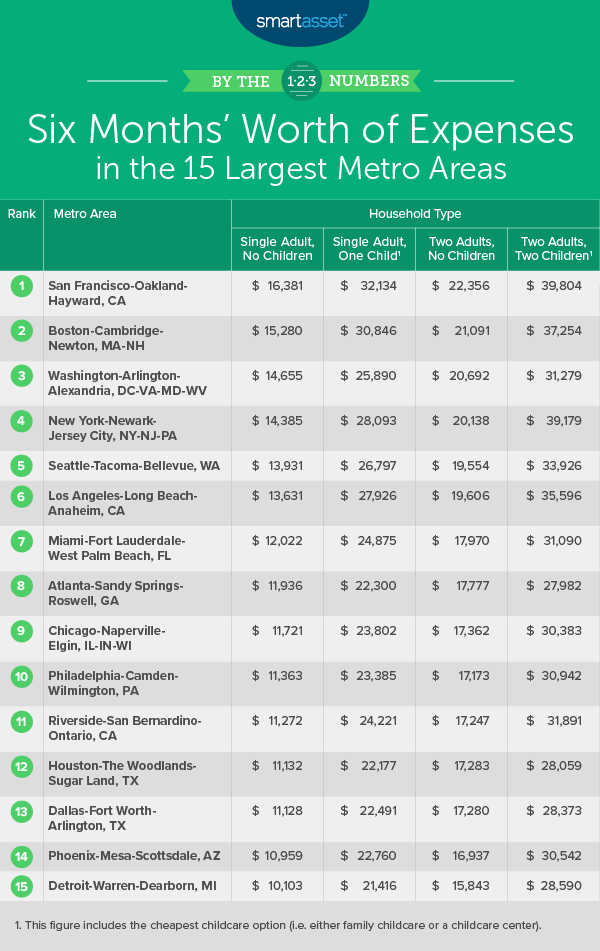
Amid health and economic upheaval from the COVID-19 pandemic, the need for an emergency fund has become increasingly pronounced. Though conventional wisdom advises having three to six months’ worth of expenses saved up, the uncertain timeline of the coronavirus crisis highlights the importance of having a full six months’ worth socked away. But what does that six-month budget even look like for individuals and families? widely by place. The numbers vary widely by place.
In this study, SmartAsset investigated what six months’ worth of expenses looks like in the 15 largest metro areas. We considered spending across the following categories: housing, food, childcare, medical expenses, transportation and expenses for other basic necessities. We found the average amount needed to last six months for the following four household scenarios: single adult with no children, single adult with one child, two adults with no children and two adults with two children. For details on our data and sources, check out the Data and Methodology section below.
Key Findings
- These are the averages for the four household types we considered. Across the 15 largest U.S. metro areas, these are the average amounts for six months’ worth of expenses:
- Single adult with no children, $12,660
- Single adult with one child, $25,274
- Two adults with no children, $18,554
- Two adults with two children, $32,326
- Expenses tend to be highest in San Francisco and lowest in Detroit. To cover six months’ worth of expenses, each type of household we considered would need the most money in the San Francisco metro area and would generally need the least money in the Detroit metro area. For a household with two adults and two children, however, expenses are lowest in the Atlanta metro area due to more affordable childcare costs.
- The Philadelphia metro area is the least expensive among the largest Northeastern metro areas. Philadelphia is the only Northeast metro area in which the six-month expense total for each household type is lower than the average total across all 15 big metro areas.

Single Adult With No Children
Across the 15 largest U.S. metro areas, six months’ worth of expenses for a single adult with no children ranges from $10,103 in the Detroit metro area to $16,381 in the San Francisco metro area.
Housing makes up the largest portion of expenses in every metro area. Across the three metro areas where expenses are the highest – the San Francisco, Boston and Washington D.C. metro areas – covering housing costs for six months would require an average of at least $9,045 on hand. Across the three metro areas where expenses are the lowest for this household – the Detroit, Phoenix and Dallas metro areas – an individual with no children would need to an average of $4,347 saved up to cover housing costs in the event of a job loss.
While transportation generally makes up the second-largest expense category for a single adult with no children, food and medical expenses comprise significant costs as well. The average cost of food for six months across the 15 largest metro areas is $1,655 while the average medical expenses total approximately $1,200. Six months’ worth of medical expenses for a single individual with no children ranges from $980 in the Seattle metro area to $1,462 in the Boston metro area.
Single Adult With One Child
In many of the 15 largest U.S. metro areas, six months of expenses for a single adult with one child are roughly double the expenses for a single adult with no children over the same time period. A single adult with a child in San Francisco area would need $32,134 to cover half a year’s expenses. In the Miami metro area, this individual would need about 23% less over the same period of time, or a total of $24,875. In the Atlanta metro area, a single parent with a child would need almost 31% less than in San Francisco, or a total of $22,300 to cover food, shelter and other needs for half a year.
Across the 15 largest U.S. metro areas, six months’ worth of housing costs average $8,794 for a single adult with one child. In six of those areas, housing costs exceed the average and reach upwards of $15,000 in places like San Francisco. In difficult economic times, a lack of mortgage or rent relief could make it difficult for households like this one to stay afloat if they don’t have enough saved.
After housing costs, childcare is the second-largest expense category for a single adult with one child in seven of the places in our study: the Los Angeles, Riverside, San Francisco and Seattle areas on the West Coast and the Boston, New York and Philadelphia areas in the Northeast. For this type of household across our study, average childcare costs – which account for the cheapest childcare option (i.e. family childcare or a childcare center) – come to about $3,900 across all 15 areas. Furthermore, six months of food costs an average of almost $2,500, and six months of transportation costs about $4,000 on average.
Two Adults With No Children
For a household with two working adults and no children, six months’ worth of expenses is highest in the San Francisco metro area – at $22,356 – and lowest in the Detroit metro area – at $15,843. The average amount across all 15 of the largest U.S. metro areas is $18,554, with nine metro areas falling below this average.
Housing costs again make up the largest share of expenses, ranging from $3,733 for six months (or about $622 per month) in the Detroit metro area, to $4,900 (or about $808 per month) in the Houston metro area, to $10,065 (or about $1,678 per month) in the San Francisco metro area. Across all metro areas in our study, two working adults with no children would need $3,034, on average, to cover food. That is almost double the average cost of food for only one working adult, but only about $600 more than the average cost of food for one adult with one child.
Two Adults With Two Children
In the 15 largest U.S. metro areas, for households that have two working adults and two children, six months’ worth of expenses reaches almost $40,000 in the San Francisco metro area. The lowest end of the range of expenses falls in the Atlanta metro area, where six months’ worth of expenses amounts to $27,982.
In households with two children, childcare (which, in our study, includes the cheapest family childcare or childcare center option) takes a fairly large share of expenses, averaging $6,366 across all the places we considered. Furthermore, childcare costs exceed housing costs in three metro areas: Phoenix, Detroit and New York.
As far as being able to afford food for six months, the average amount that this type of household would need across all the metro areas in our study is $4,878, which is almost three times the amount that a single adult with no children would need ($1,655) to do the same. Medical costs for this household over six months would range from $2,829 in the Seattle metro area to $4,097 in the Washington, D.C. metro area.
Data and Methodology
To calculate six months’ worth of expenses in the 15 largest U.S. metro areas, we found the annual cost of living in each metro area – including housing costs, food, childcare, medical expenses, transportation and other basic necessities (including clothing, personal care items, etc.) – and divided it in half. Figures for childcare costs include the cheapest family childcare of childcare center option. We looked at four household scenarios:
- One adult with no children
- One adult with one child
- Two working adults with no children
- Two working adults with two children
Data comes from the MIT Living Wage Calculator and was pulled in March 2020.
Tips for Managing Your Savings
- Reassess your budget if possible. One of the best ways to prepare for the unknown is by having an emergency fund. Again, though financial advisors typically recommend you should have savings that can cover at least three months’ worth of expenses, six months’ worth may be a better figure to shoot for during a recession. Use SmartAsset’s budget calculator to see how the coronavirus stimulus payments (if you’re eligible) could fit into your spending plan and how cutting back on discretionary expenses can increase your savings rate.
- If you did lose your job, find out if you qualify for unemployment. Many unemployment benefits across states have been expanded as a result of the spread of coronavirus. Our guide on enhanced unemployment benefits during the coronavirus crisis can help you figure out if you may be eligible for receiving unemployment benefits that can help you cover your expenses long-term when you don’t have a regular income. If you are looking for more general information on the coronavirus and what the government is doing to help, check out our comprehensive guide here.
- You don’t have to endure this alone. Looking for help navigating the economic downturn that’s come as a result of the COVID-19 pandemic? Consider finding a financial advisor. Finding the right financial advisor who fits your needs doesn’t have to be hard. SmartAsset’s free tool matches you with financial advisors in your area in just five minutes. If you’re ready to be matched with local advisors that will help you achieve your financial goals, get started now.
Questions about our study? Contact press@smartasset.com
Photo credit: ©iStock.com/Ivan-balvan